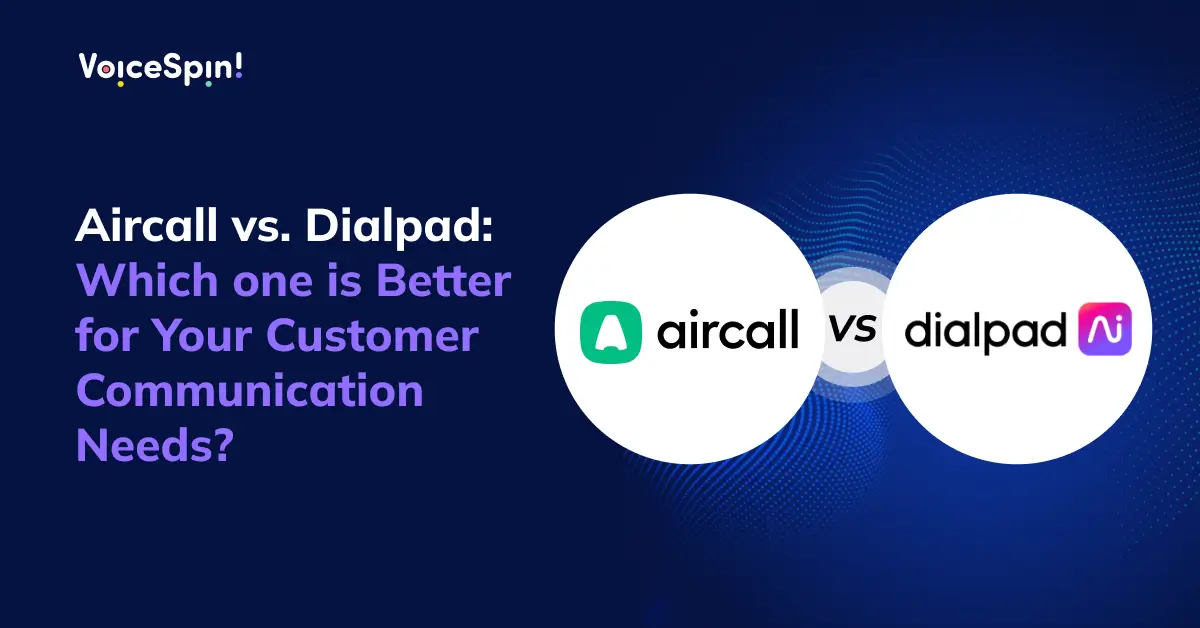Sales calls are undoubtedly an essential part of the sales process for many businesses and organizations, especially those that rely on cold calling.
Though there are many factors that can affect whether or not a sales rep will end up converting a lead and closing a deal, being prepared and knowing how to navigate every sales call, how to present your sales pitch, and handle objections can make a difference between a successful sales call and a disastrous one.
At VoiceSpin, we believe that with the right strategy in mind and tools at your disposal, nearly every sales call can be efficient. That’s why, in this blog, we’ve come up with the top 5 things to pay attention to when making sales calls, no matter what products or services you are selling or who your prospect is, to ensure a positive outcome.
These strategies are based on over 15 years of our own experience and the experience of our customers.
How to Prepare for a Sales Call
Having a clear understanding of what you are going to talk about, how you will present your sales pitch, and what desired outcome you aim to achieve is the foundation of having a meaningful conversation with each potential customer.
These are some of the most fundamental questions sales reps should answer before every sales call:
- What is the purpose of this call?
- What outcome do I want to achieve?
- What questions should I ask a prospect?
- What are the common needs and pain points a prospect might have?
- What objections might be raised?
- How am I going to address these objections?
Unless you are doing cold calling when you literally have no information about your potential leads, it also makes sense to take the time to research your potential customers if you know who you’re calling.
That may include checking your prospect’s website, their LinkedIn profile, Twitter page, the history of previous conversations in your CRM records, researching competitors and latest industry trends, etc. – anything that can help you understand your prospect’s needs so you can better tailor your conversation and sound more professional during the interaction.
That said, you should also have realistic expectations, considering that the average success rate for cold calls is around 2% while calling warm leads generates a success rate of up to 40%.
Top 5 Things to Do on Every Sales Call
1. Navigate a sales conversation with confidence
Having well-thought-out and well-written call scripts at hand helps sales agents navigate every call with more confidence, so they can start the call, pitch their offer, and close the conversation in a professional way.
Ready-made scripts provide sales reps with all the critical information they need to better navigate through various situations and ensure nothing slips through the cracks during the conversation. That also helps maintain consistency in delivering your message and enables agents to focus more on how the message is being communicated rather than what to say.
If you need some inspiration for creating your call scripts, check out these 25 cold calling script template examples.
When using call scripts, however, the key is to make sure they have a conversational tone and sound as natural as possible – otherwise, it would be challenging to build rapport with the prospects. Sales agents should also be able to go off script and improvise whenever appropriate to get the conversation flowing naturally.
2. Ask open-ended questions and evoke emotions
Asking questions that can’t be answered with a simple ‘yes’ or ‘no’ is a great way to qualify leads, which is one of the most important things to do on a B2B sales call. It helps reveal a prospect’s goals, needs, authority level, and budget.
Besides, it allows reps to save time by quickly disqualifying those who simply don’t have a problem that your product can solve, cannot afford your product, cannot approve the purchase, or aren’t ready to buy now. By asking open-ended questions, you not only qualify leads, but can also gather other critical information that can help you tailor your offering and close the deal.
Another essential thing to pay attention to during a sales call is to focus on the emotions that your product or service evokes. It’s no secret that consumers are rarely guided by solely rational grounds in their buying process. In many cases, if not most, your prospect’s purchase decision will be influenced by the emotional triggers your product appeals to. By tapping into a prospect’s emotions with your product, you increase your chances of successfully closing a sales deal.
3. Leverage real-time call intelligence
Due to advancements in technologies driven by Artificial Intelligence (AI), Machine Learning (ML), and Natural Language Processing (NLP), sales teams have now a wider range of tools that can assist them in the calling process and help improve call conversion rates.
E.g., with call center speech analytics software such as VoiceSpin’s Speech Analyzer, agents can leverage real-time conversational intelligence to better identify prospects’ intents, expectations, preferences, and objections even if they don’t mention those directly in the conversation.
When tracking sentiment analysis, the software extracts subjective information from the speech, such as emotions and attitudes, and helps determine the emotional tone of a prospect and whether they feel positive or negative about the interaction.
Sales representatives can take advantage of these real-time insights during calls to tailor their pitch and adjust the conversation to meet the prospect’s needs and achieve better outcomes of every sales call.
4. Shift the focus from product to value
While it is common for salespeople to talk more about a product’s features and technical aspects, the reality is that people mostly care more about what the product can do for them. Instead of listing features and functionalities, shift the focus to conveying the value it brings to your prospect. Think about their needs and pain points, and how exactly your product can help them save time, increase efficiency, reduce costs, or whatever it can assist them with.
You can also share real examples, case studies, and success stories of how your product or service has helped other customers or businesses similar to the prospect’s solve their challenges and reach their goals. That helps your potential customers better understand your product’s value.
5. Handle sales objections with risk-reversal language
Handling objections might be the most challenging aspect of a sales call, but mastering it can significantly impact a sales agent’s ability to convert leads into clients. One of the highly efficient ways to handle objections is using the so-called risk-reversal language, a closing technique used in sales to address objections by reframing them into a positive statement or question.
E.g., if a potential customer is concerned about the product’s price and isn’t sure if it’s worth the money, an agent can re-assure them that there’s nothing for them to lose by saying something like ‘If you’re not satisfied with our product, we offer a 30-day money-back guarantee’. It helps agents build trust and credibility with prospects and close more sales deals. In fact, using a risk-reversal strategy is known to increase sales win rates by 32%.
Bonus Tip: What to Do After a Sales Call
While making notes in your CRM and scheduling the next call (if necessary) are some of the most obvious things to do after the sales call, you can also take some time to evaluate your past calls by listening in to call recordings or reviewing call transcripts, which is often a common feature of call center software tools.
Reviewing call recordings allows you to assess your performance and understand what went wrong and what could be done better on the next call. You can also play back call recordings or review call transcripts whenever you need to make a follow-up call, so you can easily pick up where you left off.
Key Takeaways
Calling prospects or cold leads might not be the most fun part of a sales agent’s daily routine, but paying attention to the top 5 things to do on every sales call described above and being well-prepared ensures you can navigate each sales call with confidence, convey your product’s value to a potential customer, and handle objections professionally.
The process of calling your leads can be simplified and optimized by using the right tools, such as VoiceSpin’s call center software solutions. With an AI auto dialer featuring an intelligent lead and agent scoring system, you can ensure your leads are connected to the most appropriate sales agents, increasing sales call conversion rates.
By taking advantage of speech analytics and sentiment analysis, agents get access to real-time call insights that can help them better tailor each conversation.
Finally, using tools like call monitoring and having instant access to recordings and transcripts of every sales call, you ensure agents never miss a detail of what was said during each call.
Book a 30-minute demo now to learn more about how VoiceSpin’s call center software solutions can help you maximize your sales team’s potential, enabling them to have more meaningful conversations and turn them into sales conversions through advanced AI-powered features.





 +18889082995
+18889082995
 +442036084160
+442036084160
 +97237237006
+97237237006